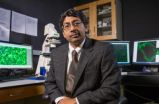(Press-News.org) TEMPE, Ariz. – Nanoscale technology looks promising as a major contributor to advancements needed to fulfill the potential of emerging sources of clean, renewable energy.
Progress in the comparatively new area of nanoelectronics in particular could be the basis for new manufacturing processes and devices to make renewable energy systems and technologies more efficient and cost-effective.
Stephen Goodnick will focus on what nanoelectronics advances could do to help push the performance of solar energy systems to the next level in his talk at the 2014 annual meeting of the American Association for the Advancement of Science (AAAS) Feb. 13-17 in Chicago.
His presentation will lead off a session on Feb. 16, from 1:30 to 4:30 p.m., titled "Nanoelectronics for Renewable Energy: How Nanoscale Innovations Address Global Needs."
Goodnick is a professor in the School of Electrical, Computer and Energy Engineering, one of Arizona State University's Ira A. Fulton Schools of Engineering.
Titled "Pathways to Next-Generation Photovoltaics," Goodnick's presentation will look at how innovations driven by nanoelectronics research can enable photovoltaic technology to significantly improve our ability to convert sunlight and heat into electric power.
He'll specifically delve into how new types of nanostructure-based devices can make it possible to produce photovoltaic solar cells that achieve better energy-conversion efficiency.
Goodnick explains that the key is in the different characteristics, properties and behavior of materials at the nanoscale.
A nanometer is one-billionth of a meter (one meter is a little more the 39 inches long). About 100,000 nanometers amount to the same thickness as a typical sheet of paper.
At that tiny scale, silicon and other materials that are used to make solar cells can perform in ways that boost the effectiveness of devices for producing energy, Goodnick says.
"With the use of nanoparticles, made into nanostructures, we could, for instance, improve optical collection, enabling systems to trap more light for conversion into electrical power," he says.
"Using nanomaterials, we could make solar cells even thinner but still more efficient, and we could increase the capacity of energy-storage devices," he says.
Such progress will hinge on the success of science and engineering research in overcoming current high production costs and some technical challenges. But Goodnick says he's confident nanotechnology advances "are going to be big factors in the future of energy."
Goodnick's talk is part of an AAAS conference session that will also feature additional presentations on aspects of nanoelectronics and renewable energy by four other scientists and engineers who will join Goodnick in a research collaboration beginning in July at the Institute for Advanced Study at the Technical University Munich in Germany.
Goodnick has been awarded the German university's Hans Fischer Senior Fellowship, which will enable him to spend six months conducting research at the institute this year. The fellowship award is given to engineers and scientists doing innovative work in areas of interest to the institute.
INFORMATION:
Nanoelectronics key to advances in renewable energy
2014-02-17
ELSE PRESS RELEASES FROM THIS DATE:
Epigenetic regulation required to ensure correct number of chromosomes
2014-02-17
Abnormal number of chromosomes is often associated with cancer development. In a new study published in the journal Nature Structural and Molecular Biology researchers at Karolinska Institutet in Sweden have shown that a subtle epigenetic change plays an important role in the correct segregation of chromosomes.
Normally when a cell divides, the chromosomes are segregated equally to two daughter cells. However, tumour cells frequently have either too few or too many chromosomes, leading to the incorrect expression of a number of genes. When a cell is about to divide, the ...
New eye layer has possible link to glaucoma
2014-02-17
A new layer in the human cornea — discovered by researchers at The University of Nottingham
last year — plays a vital role in the structure of the tissue that controls the flow of fluid
from the eye, research has shown. The findings, published in a paper in the British
Journal of Ophthalmology, could shed new light on glaucoma, a devastating disease caused by
defective drainage of fluid from the eye and the world's second leading cause of blindness.
The latest research shows that the new layer, dubbed Dua's Layer after the academic Professor
Harminder Dua who ...
Researchers hijack cancer migration mechanism to 'move' brain tumors
2014-02-17
One factor that makes glioblastoma cancers so difficult to treat is that malignant cells from the tumors spread throughout the brain by following nerve fibers and blood vessels to invade new locations. Now, researchers have learned to hijack this migratory mechanism, turning it against the cancer by using a film of nanofibers thinner than human hair to lure tumor cells away.
Instead of invading new areas, the migrating cells latch onto the specially-designed nanofibers and follow them to a location – potentially outside the brain – where they can be captured and killed. ...
U of M study finds fertilization destabilizes global grassland ecosystems
2014-02-17
A new study led by University of Minnesota researchers demonstrates that fertilization of natural grasslands -- either intentionally or unintentionally as a side effect of global farming and industry -- is having a destabilizing effect on global grassland ecosystems. Using a network of natural grassland research sites around the world called the Nutrient Network, the study represents the first time such a large experiment has been conducted using naturally occurring sites.
Led by Yann Hautier, a Marie Curie Fellow associated with both the Department of Ecology, Evolution, ...
New study shows growing opposition to animal tests
2014-02-17
Chicago — Americans' moral opposition to animal testing
has grown significantly since 2001, according to a new study presented today at the annual
meeting of the prestigious American Association for the Advancement of Science (AAAS) in
Chicago. Researchers from PETA and Western Governors University examined data collected
in independent surveys by the Gallup organization from 2001 to 2013, in which approximately
1,000 American adults each year were asked whether they found "medical testing on animals" to be
"morally acceptable" or "morally wrong."
The researchers ...
Mount Hood study suggests volcano eruptibility is rare
2014-02-17
Forecasts of when a volcano is ready to erupt could be a little closer thanks to work by
geologists at the University of California, Davis, and Oregon State University published online Feb.
16 in the journal Nature.
For an eruption to occur, the magma, or molten rock under the volcano must be sufficiently
mobile to erupt.
"The question is, what percentage of time is the magma in an eruptible state?" said Kari
Cooper, associate professor in the Department of Earth and Planetary Sciences at UC Davis and lead
author on the paper.
"People think about there being ...
Volcanoes, including Mt. Hood, can go from dormant to active quickly
2014-02-17
CORVALLIS, Ore. – A new study suggests that the magma sitting 4-5 kilometers beneath the surface of Oregon's Mount Hood has been stored in near-solid conditions for thousands of years, but that the time it takes to liquefy and potentially erupt is surprisingly short – perhaps as little as a couple of months.
The key, scientists say, is to elevate the temperature of the rock to more than 750 degrees Celsius, which can happen when hot magma from deep within the Earth's crust rises to the surface. It is the mixing of the two types of magma that triggered Mount Hood's last ...
River samples shed light on the spread of potential 'superbugs'
2014-02-17
The spread of antibiotic-resistance to one of the most pristine locations in Asia is linked to the annual human pilgrimages to the region, new research has shown.
Experts from Newcastle University, UK, and the Indian Institute of Technology in Delhi (IIT-Delhi), sampled water and sediments at seven sites along the Upper Ganges River, in the foothills of the Himalayas.
They found that in May and June, when hundreds of thousands of visitors travel to Rishikesh and Haridwar to visit sacred sites, levels of resistance genes that lead to "superbugs" were found to be about ...
New blood cells fight brain inflammation
2014-02-17
Hyperactivity of our immune system can cause a state of chronic inflammation. If chronic, the inflammation will affect our body and result in disease. In the devastating disease multiple sclerosis, hyperactivity of immune cells called T-cells induce chronic inflammation and degeneration of the brain. Researchers at BRIC, the University of Copenhagen, have identified a new type of regulatory blood cells that can combat such hyperactive T-cells in blood from patients with multiple sclerosis. By stimulating the regulatory blood cells, the researchers significantly decreased ...
Iowa State University's Wintersteen talks partnerships at national science meeting
2014-02-17
AMES, Iowa – Wendy Wintersteen, dean of Iowa State University's College of Agriculture and Life Sciences, spoke on Sunday of the importance of public-private partnerships in strengthening global food security during the annual meeting of the American Association for the Advancement of Science in Chicago.
During her talk, part of a panel on research and development for sustainable agriculture and food security, Wintersteen stressed the importance of partnerships in providing the innovation necessary to meet global challenges.
She said climate change, pests, plant ...


